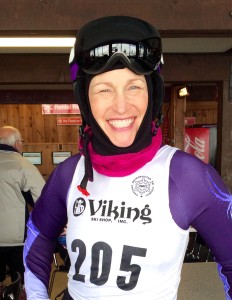With the change of seasons from summer to fall, my attention shifts from the flatlands of Chicago that I call home to the mountains of Colorado and the start of ski season. I recently reclaimed this beloved sport from my youth after a few decades-long hiatus (first due to lack of funds while working in the arts, and later succumbing to the challenge of rustling up interested friends to join me on the adventure). Today, I not only have recruited my wife and a few hearty friends, but joined a local ski club that offers me many opportunities to ski all season.
Even more than the skiing, I have fallen back in love with Alpine racing, a sport that all but ruled my life as a teenager growing up in Iowa (yes, I was a ski racer from Iowa, and that is another story altogether). Returning to racing in mid-life I can confidently say that Lindsay Vonn’s records are safe. And while each race lasts only 30-45 seconds and, at most, a race day will include four races, reclaiming my identity as an amateur athlete has had a positive impact well beyond my success in any individual race, race day or ski season—To be prepared for those races and ski season, I am motivated to maintain my fitness and agility throughout the year to be competitive.
Life-long physical fitness is characterized by strength, mobility, flexibility, stamina and balance (Nagasaki, Itoh, & Furuna, 1995), of course, with a healthy mix of rest and recovery. While, for me, those short races are a blip on the wider landscape of the ski season, not to mention my day-to-day life, to be able to negotiate the literal twists and turns of the race course, the unexpected patches of ice, the rut that wasn’t there the last run, I must arrive in the starting gate fit and agile. The same holds true for your business. While many of your day-to-day responsibilities or operations may be routine, you must always be prepared for the unexpected and unplanned, as well as constantly scanning the environment for new opportunities and challenges. To do so, consider how the characteristics of fitness translate to your organization. Could your organization pass a fitness test in each of these areas?
- Strength (do you know your strengths and consistently build on and leverage them?)
- Mobility: Are you and your workforce able to move with the needs of the market?
- Flexibility: Have you developed the competence and capacity to adapt when things don’t go as planned?
- Stamina: Have you built systems, processes and a culture that supports sustained success?
- Balance: Does your organization have access to a diverse network of skills, knowledge, talent and resources to respond to opportunities and challenges as they arise?
Just as physical fitness is not attained simply by purchasing a gym membership, or working out with a trainer for a few months, organizational fitness requires a sustained commitment in each of these areas.
•••••
Nagasaki, H., Itoh, H., & Furuna, T. (1995). A physical fitness model of older adults. Aging, 7(5), 392-397.

